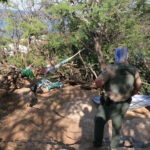
This week over 30 homeless camps on both sides of Diamond Head are being cleaned-up as part of a larger statewide coordinated effort to manage threats to natural and cultural resources on State lands and parks under DLNR jurisdiction.
The statewide efforts by DLNR are not focused only on cleanup and enforcement of “no camping” rules, explained Pua Aiu, who serves as homeless coordinator for DLNR. “Housing is a piece, outreach is a piece, and enforcement is a piece of the plan and if you don’t have all three, it’s not going to work,” said Aiu in a press release.
DLNR uses a private contractor to store or dispose items encountered at Diamond Head camp sites. Law enforcement support for the clean-up operations is provided by officers from the DLNR Division of Conservation and Resources Enforcement (DOCARE), and by officers from the Honolulu Police Department District 7 Community Policing Team.
“Having HPD join us has been very helpful because they can easily make connections between what may be happening in Waikīkī and what’s happening on Diamond Head. Our officers cannot always make those connections because they only patrol DLNR lands,” Aiu added.
At Diamond Head, other key partners are case workers from the Institute for Human Services, the City T.E.A.M. Work Hawaii program, and social work students from the University of Hawai’i Thompson School of Social Work and Public Health, who assist in outreach and notification to homeless individuals prior to the enforcement. Outreach is offered in conjunction with shelter and housing programs, such as the City and County of Honolulu’s Housing and Outreach Navigation for Unsheltered (HONU) program.
DLNR will continue clean-ups on its properties throughout April at locations including Kapena Falls, Sand Island State Recreational Area, and on unencumbered lands in Kapolei and Leeward O‘ahu.
Image courtesy of DLNR